Buying a travel trailer is a big decision.
A lot of thought goes into it, not to mention a lot of your available budget! In terms of purchase, one of the most important things to consider is the size.
In this article, we will take a closer look at two popular types of motorhomes—Class As and Class Cs. These have captured the dreams of potential RVing enthusiasts with their luxurious offers, sturdiness, and durability.
We’ll take a closer look at size, how best to store the RV, and why the height of your RV matters.
Why Height Matters

Besides winter storage, knowing the height of your recreational vehicle is important for a few other reasons.
Remember that you will be driving the vehicle, and a super tall RV is impossible to squeeze under low bridges.
For just about any RV trip, you should plan your route with height restrictions in mind. Arriving at a low clearance overpass will give you headaches. Remember your vehicle’s true height (its highest point, i.e., including the air conditioning unit and anything else that adds to it), and watch closely for any clearance signs!
There’s nothing more annoying than reaching a low overpass, finding out that your RV can’t pass, and having to turn around and plan a different route. Your RV GPS system will help with rerouting, but you’d have to drive the new route.
Sometimes you might think you can pass because your recreational vehicle’s defined height is lower than the one stated on the clearance sign—only to forget about your air conditioner and cause serious damage. Don’t believe me? Have a look for yourself how owners and renters destroy the ACs of their camper vans on overpasses:
Did you know that many states in the US have a maximum height restriction of 13 feet 6 inches?
Using gas stations can also prove difficult. Although most, particularly in big towns or cities, have a roof that can accommodate tall vehicles, some smaller stations do not.
Campgrounds can also have maximum height restrictions, again, this is something you’ll need to investigate before setting out if you’re traveling in a very tall RV.
In terms of driving and towing, a lofty RV is more prone to wind drift. Keeping the vehicle straight on the road requires a lot more attention than with a shorter camper. Having a camper with a fifth-wheel can help significantly, so check the manufacturer’s website for such offers.
How Tall Are Class C Motorhomes?
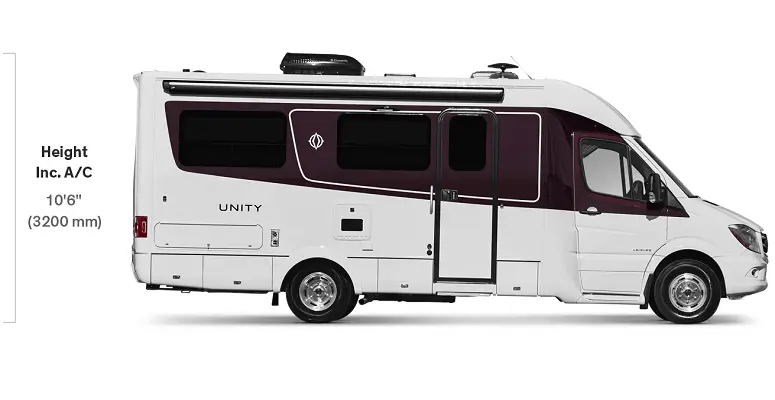
The height of a Class C motorhome is generally between 10 and 12 feet, with an average height of 11 feet.
To be sure, check your owner’s manual. There you can check for the specified factory height of your travel trailer. You can also explore the floorplan, which can also give you an idea of your RV’s width—an important fact, particularly if you have a camper with slideouts, or with a fifth wheel.
Usually smaller than a Class A, these RVs tend to be a favorite among first-time RVers—and they are also more readily accepted in national parks.
The whole “home” is built on a van or truck chassis. This makes the front end look like a regular pick-up truck.
When buying a Class C, you can choose between different truck models, a popular choice is Ford since these have a strong and reliable motor.
Although the Class C motorhome might not look as fancy as a Class A RV, it’s still a contender. The inside of a Class C can be just as luxurious and spacious.
As a bonus, because of the truck chassis, many people find that these are easier to manage on the road. They aren’t as large-and-in-charge, and driving one is similar to driving a pick-up truck.
Example Class C Heights
Jayco Redhawk 2017: 11 feet 6 inches.
Winnebago View 2019: 11 feet 2 inches.
Thor Quantum 2019: 11 feet.
Why Choose A Class C?
Class C motorhomes are a nice mid-way point between luxurious Class As and the smaller Class Bs.
Here are some other highlights:
- Lots of sleeping space – some models can fit eight or more people.
- Easier to drive in all weather conditions.
- Closer to the ground – more comfortable to get in and out of.
- Less space that needs to be cooled or heated – saves energy.
How Tall Are Class A Motorhomes?

Starting at around 11-foot tall, with the tallest generally being 13.5 feet (due to the height restrictions mentioned above), the average height of this class is around 13 feet.
However, with AC units, satellite dishes, and other extras, the height of a Class A can easily add another two feet.
Again, to be sure, check your owner’s manual for the defined factory height. Then add to that value anything you added on the top of your recreational vehicle—and keep this number in mind when watching for low-clearance signs near approaching overpasses.
These are the big boys. These resemble buses, but on the inside, they often look like a five-star hotel room. And they are ideal for the strongest RVing enthusiasts out there.
The drawback is that they can be tricky to master in terms of driving and towing, due to their sheer size and weight. These typically don’t have a fifth-wheel to help, unfortunately.
Some of the perks of these large RVs include larger bathrooms, washer and dryer, master bedroom suites, and slideouts — the list goes on.
People who spend lots of time on the road tend to prefer a Class A RV—and no wonder.
Although, there are certain downsides as well. Chief among them is that driving this type of vehicle on small roads can be close to impossible if you’re not experienced.
Example Class A Heights
Fleetwood Bounder 2019: 12 feet 10 inches.
Prevost H3-45 2016: 12 feet 5 inches.
Magna 630 Rembrandt 2007: 12 feet 10 inches.
Why Choose A Class A Model?
Besides the extra luxury, here are a few highlights:
- More space.
- Plenty of storage – suitable for large families.
- Excellent for long travels.
- Large slide-outs.
Will My RV Fit In My Garage?
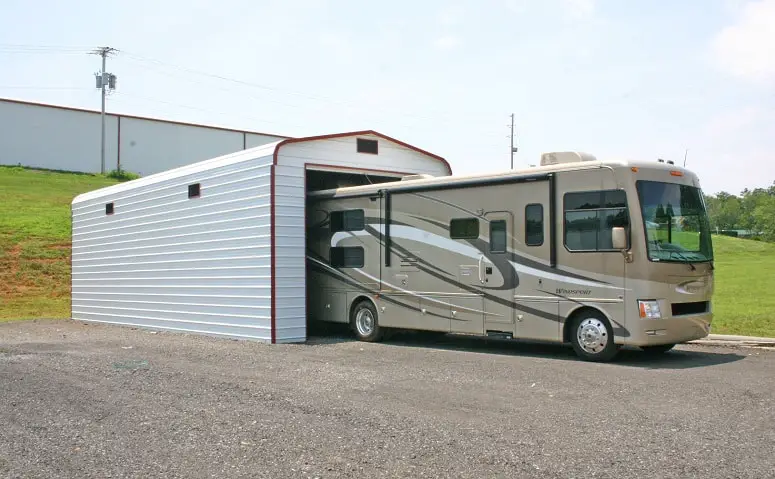
Whether or not it will fit depends on the size of your garage/awning, and the height of your RV.
A regular garage probably won’t be able to fit a Class C.
In saying that, there are garages that are built explicitly with RVs in mind.
These will usually be just high enough to fit the average Class C RV inside.
A couple of adjustments may be possible to get your Class C inside if it doesn’t quite fit. You can change the location of the garage door opener. These are usually installed at the top of the door, but this can cost you a few inches of height.
Instead, you can install it on the side of the door. These are called slim-profile door openers but are sometimes referred to as screw-type openers.
If your Class C has an air conditioning unit on the roof, it may be possible to have it moved from the top to the side. This can save several inches. But then you have to make sure there’s enough space for the AC unit to come in from the side.
Class A models are a different story, though. As these are quite a bit taller and longer, you’ll more than likely have to store them in a purpose-built location.
Although, if you have enough space outdoors, you could have a garage custom made, specifically for your big boy.
Will A Cover Be Enough?
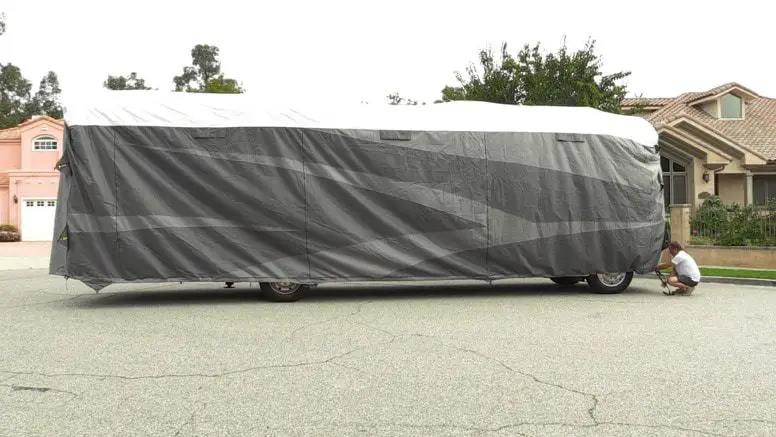
Theoretically, it would be convenient just to throw a cover on the RV and call it a day. However, these can be unpredictable.
If they aren’t appropriately fitted they could fly off in windy weather. And if that happened, it could cause some damage to the exterior.
Protruding antennas or satellites could damage a cover, maybe even pierce through it, which could, in turn, cause water to leak in, destroying the important electrics on the roof.
It may also cause water or moisture to get stuck inside, which could have catastrophic results.
Additionally, the cover itself will require a lot of storage space and maintenance. When storing it, you have to make sure it’s completely dry, otherwise, mildew can grow and accumulate.
Then it will need to be washed and dried before covering the RV again—not an easy task.
You will also have to consider the foundation your RV is standing on. It should be concrete, preferably. Never leave your heavyweight on grass or a soft surface like dirt.
During the winter or rainy months, this type of ground will become even softer and it could cause your travel trailer to “settle,” making it close to impossible to get out. Not to mention, it will damage the area and the tires.
Where Else Can I Store My Motorhome?
If your home garage isn’t an option, you might consider a storage garage.
These are costly, but it’s important to make sure that your investment is safe and secure.
There are generally three types of storage options you can choose from, all come at different price points:
- Outdoor: Your travel trailer will be stored out in the open. Consider weather conditions, if you live in a dry, warm area it might be enough.
- Covered: Here your motorhome will be covered, it will be safe from rain, snow, and sun, but not from frigid temperatures.
- Indoors with heating: This is the most expensive option, but, your RV will be safe and sound in optimum conditions.
Decide for yourself what is best. If all you need in your garage is a couple of inches, consider changing the door function.
Storing the RV at home will be much cheaper, and more convenient, in the long run.
Why It’s Essential To Store Your Motorhome When Not In Use
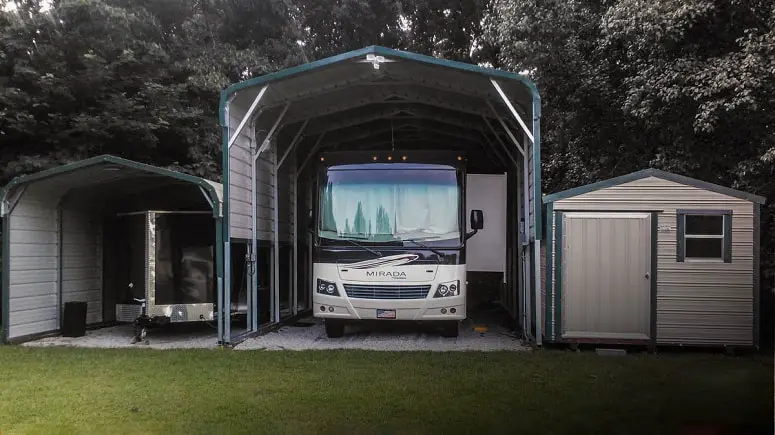
Leaving your RV out in the open during the winter could cause a significant amount of damage.
Depending on where you live, the winters might be wet and cold.
Returning to your RV once the season starts again, you might find leaks and damage on the inside and outside. The exterior might have faded or peeled off.
Not to mention the possibility of a few unwanted guests. Critters such as rats and insects might have used your home-away-from-home as a five-star winter get-away.
RV batteries can also become damaged if left in freezing temperatures.
The best thing to do is to remove the batteries completely before storing your RV.
The tires may also be affected when not in use. They can quickly develop “flat spots” due to the immense weight and constant pressure. The best way to fix this is by removing the tires before storing your travel trailer. If that’s not an option, you might have to move it occasionally to change the pressure points.
If you choose to leave the tires, you will have to attach the battery every time you need to move the vehicle.
If you ever plan on reselling your RV, caring for it is crucial. If there are any rusty spots, damage to the exterior, or mold, the price will go down significantly.
Just think, if you were going to buy a used motorhome, would you consider one with a strong musty odor?
At The End Of The Day
Where you’re going to store your motorhome should be thought of before you buy the actual vehicle.
Deciding where to store it can also help you choose the model that fits your budget best.
Class A RVs might be the camping dream, however, the size has to be taken into consideration. Although the average Class A RV isn’t that much taller than the average Class C RV, it’s much longer. The extra length can make it difficult to both store and drive.
Did we miss anything? If yes, do tell us in the comment section below.


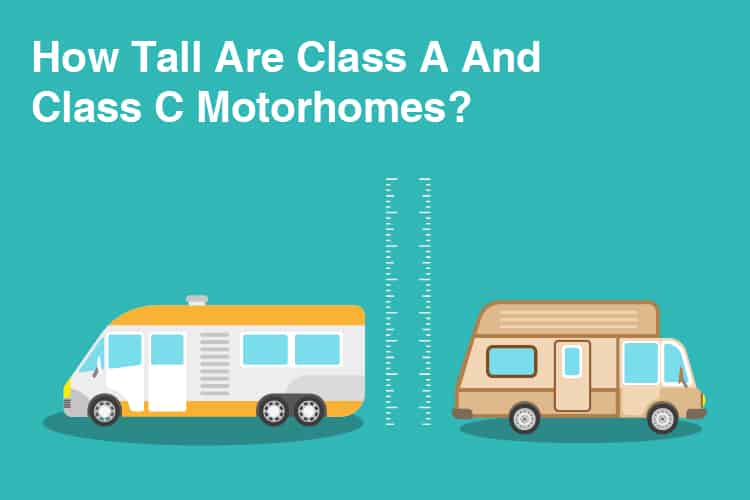

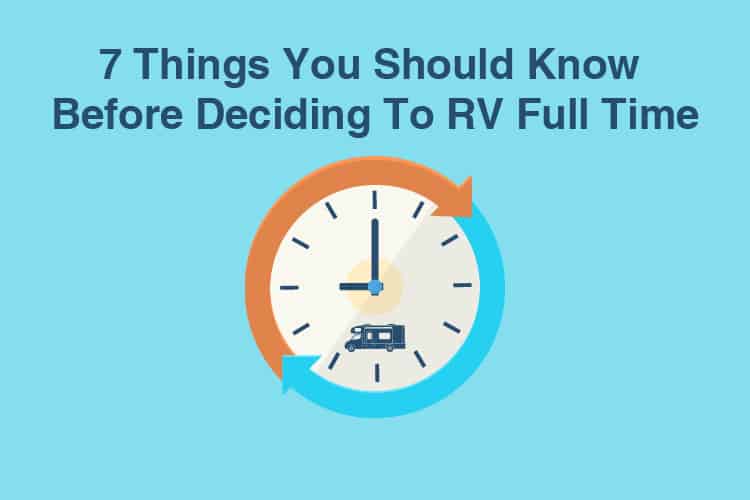

I plan to see as many state and national parks as possible would you recommend class a or c? I’m sure some dont allow huge class a’s.